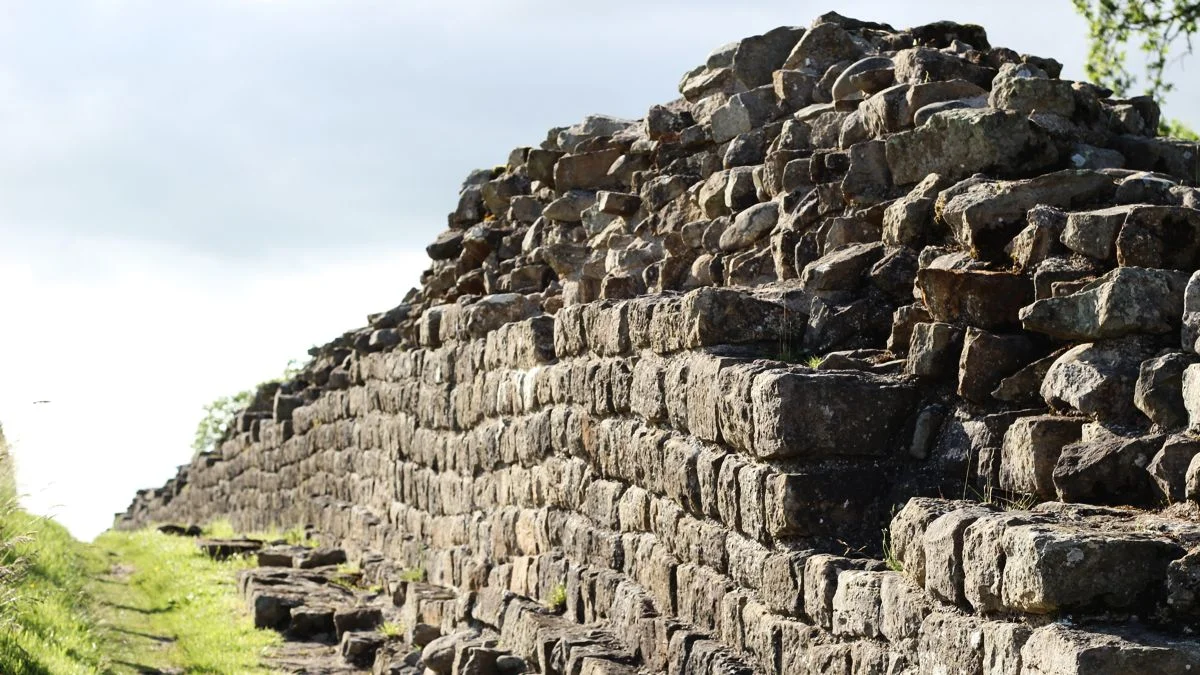Saturday, 04-07-2015. Day 318.
New Shoes and an Ancient Wall
Shortly after we left Olney, heading toward Scotland, we stopped for a late breakfast at a place called Buddies USA (I think it was the one in Northampton).
It was, after all, the fourth day in July, and while that date doesn’t have much significance for the country we were in, stopping at an American-themed restaurant seemed like an appropriate way to celebrate ever so slightly. The food, however, was not good. This didn’t really come as much of a surprise, and I can only discourage any traveling Americans from eating here.
Independence Day Breakfast
Now, if you’re paying attention, you may be wondering why we went to Northampton on our way to Scotland. The answer, of course, was a quick stop in Wollaston.
WOLLASTON: Birthplace of Dr. Martens
Wollaston is where Dr. Martens shoes were manufactured from April 1960 until sometime in 2003. In 2007, production of the “Made in England” branded Dr. Martens came back to Wollaston where, as far as I know, they’re still being manufactured. Alas, we don’t have any pictures of our very brief stop in this small town, but Frankie did score a sweet pair of pink Dr. Martens boots for £35 at the outlet shop.
Then it was off to the border separating England from Scotland. Samantha found a nice B&B by the name of Bush Nook in Cumbria. It was just a short distance from the village of Gilsland where one of the sections of Hadrian’s Wall still stands. We arrived at Bush Nook in the late afternoon. We spent a little time checking in and getting settled before heading back out to take a gander at Hadrian’s Wall.
Hadrian's Wall
Hadrian’s Wall was build under the reign of Hadrian, the 14th Emperor of the Roman Empire (and the third of what scholars call the five good Emperors). Apparently, around the year 120 or so, Hadrian decided it was just too much work to subdue the Celts and Picts who lived in the territory north of the Roman Empire.
Instead, he decided to seal off these wild lands from the northern border of his vast holdings, building a wall that ran from one coast of the island to the other — a full 120 kilometers long. But it wasn’t just a big wall, it was also guarded by a huge number of Roman soldiers. At each Roman mile (1.48 kilometers) along the wall, there stood a Roman outpost called a milecastle.
A section of Hadrian's Wall and the Hadrian's Wall Path.
Hadrian’s Wall, part of yet another Unesco World Heritage Site (officially named Frontiers of the Roman Empire), is said to be the largest Roman artifact to be found anywhere in the world.
A convenient sign along the Hadrian's Wall Path.
It was later afternoon and we only had a few hours before the sun would be setting, so we ventured off down the path (conveniently named the Hadrian’s Wall Path) that runs alongside the wall until we came to the a bridge extending over the River Irthing. This is the river that marks the border between the English counties of Cumbria and Northumberland.
The bridge over the river Irthing.
We crossed over the bridge into Northumberland, then figured we’d gone far enough. So we crossed back over into Cumbria and ambled along the path heading back toward Gilsland, encountering a few curious English sheep along the way.
Curious English sheep along Hadrian's Wall.
Poltross Burn Milecastle
As mentioned above, a Roman outpost, most appropriately named a milecastle, stood at each Roman mile along the length of the wall. And right inside the town of Gilsland, the ruins of one such milecastle, the Poltross Burn Milecastle, still stands.
It features two barracks, one on either side of the road, a kitchen, a section of stairway that led to the ramparts of the wall, and remnants of a gateway.
Remnants of the Poltross Burn Milecastle.
After we explored the area around Hadrian’s Wall a bit more, we were losing daylight fast. So we retreated to the nearby Samson Inn for a traditional English dinner before taking the short drive back to Bush Nook where we turned in for the evening.
The next day would be a long one of driving for us — we were venturing into Scotland, heading for the small town of Dunoon to spend a little time with some old friends.

Tom Fassbender is a writer of things with a strong adventurous streak. He also drinks coffee.

















